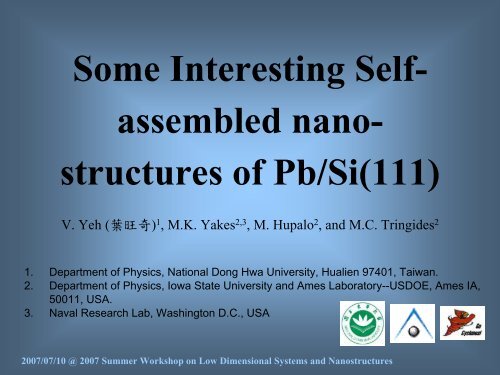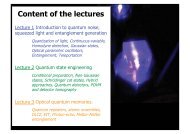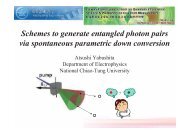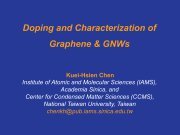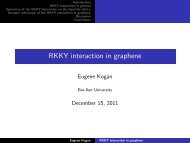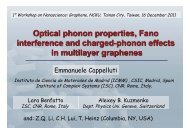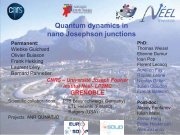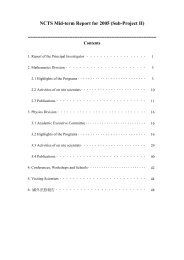Some Interesting Self-organized nano-structures of Pb/Si(111)
Some Interesting Self-organized nano-structures of Pb/Si(111)
Some Interesting Self-organized nano-structures of Pb/Si(111)
- No tags were found...
Create successful ePaper yourself
Turn your PDF publications into a flip-book with our unique Google optimized e-Paper software.
QSEDrivenGrowth Mode
K. Budde, E. Abram, V. Yeh, and M.C. Tringides, PRB 61, 10602 (2000)
Quantum well states <strong>of</strong> <strong>Pb</strong> islandsW.B. Su, S.H. Chang, W.B. Jian, C.S. Chang, L.J.Chen, and T.T. Tsong, PRL 86, 5116 (2001)A. Mans*, J.H. Dil, and A. R. H. F. Ettema, H. H.Weitering, PRB 66, 194410 (2002)
Different modes <strong>of</strong> thin film growthLayer by layerΔγ 0(Volmer-Weber)MixedΔγ < 0, then change sign(Stranski-Kratanov)Newly discovered7-layer high, flat top, steep edgeQuantum size effects (QSE)
Different stable heights with bi-layerdifference under different conditionsM. Hupalo, S. Kremmer, V. Yeh, L. Berbil-Bautista, E. Abram, M.C. Tringides, Surf. Sci. 493 (2001) 526
Comparisonbetweeninterfaces.
<strong>Si</strong>(<strong>111</strong>)-7 7θ = 3.3 ML200 nm 200 nmT = 200K3 ×3<strong>Pb</strong>/<strong>Si</strong>(<strong>111</strong>)- -βθ = 3 MLV. Yeh, L. Berbil-Bautista, C.Z. Wang, K.M. Ho, and M.C. Tringides, PRL 85, 5158 (2000)
77<strong>Si</strong>(<strong>111</strong>)-77• Wetting layer: from 3 ML at 130Kto 1 ML at RT• 4- to 9-step islands observed• For θ < 6 ML and T between 190Kand 200K, 7-step islands with meansize 90Å• At T = 195K, islands tend to stay at7-step and cover the whole surfaceat θ ~ 8ML, then new islands growon top<strong>Pb</strong>/<strong>Si</strong>(<strong>111</strong>)- 3 × 3• First layer used to cover substrateto dense phase• 2-step to 11-step islands observed• For θ < 6 ML and T between190K and 200K, 5-step islandswith mean size 180Å• At T = 195K, islands tend to growhigher, in bi-layer increments,than grow larger for up to 20MLM. Hupalo, S. Kremmer, V. Yeh, L. Berbil-Bautista, E. Abram, M.C. Tringides, Surf. Sci. 493 (2001) 526
E = E 0− E CE 0 : the energy <strong>of</strong> the <strong>Pb</strong> film (after subtracting the bulk energy)E C = C(ΔE f ) 2 : energy gain due to the charge transferΔE f = 4.75 eV for 7 7 and 4.98 eV forC = 0.033 eV/Å 2(see Zenyu Zhang, et al, PRL 80, 53813 × 3D.R. Heslina, et al, PRL 64, 1589 and H.H. Weitering, et al, PRB 45, 9126.)Calculated film energyvs film thickness L forthe two interfacesshowing the 3 × 3phase has a lower curveand different minimadue to larger chargetransfer term.V. Yeh, L. Berbil-Bautista, C.Z. Wang, K.M. Ho, and M.C. Tringides, PRL 85, 5158 (2000)
Stability<strong>of</strong>QSE driven islands.
Oxygen covered <strong>Pb</strong> islands retain theirheight to a higher temperatureOxygen suppressedatom diffusion tothe islandsS. Stepanovskyy, V. Yeh, M. Hupalo, and M.C. Tringides, Surf. Sci. 515 (2002) 187
Controlling the Thermal Stability <strong>of</strong> ThinFilms by Interfacial EngineeringD.A. Ricci, T. Miller, and T.-C. Chiang, PRL 95, 266101 (2005)
Applicability<strong>of</strong>nucleation theory.
For 2D islands and complete saturationnx= η θ⎛⎜⎝( , i)DF⎞⎟⎠−χ⎛exp⎜⎝⎛ ν0 ⎞lnx⎜ ⎟⎝ 4F⎠lnEi⎞⎟( i + 2) kT ⎠χkT( n ) = lnη− χ ln + ( E + E )( n x) ln F + const2miiχ = i + 2= χ Rate dependence( n ) ( E + E ) const.lnx= χm i+kTs = χ ( E ) m+ E ikn ν0lnx 1/⎜T = 0⎝ 4 F⎛ ⎞( ) = lnη− χ ln ⎟⎠Temperaturedependence
STM measurementsS.H. Chang, W.B. Su, W.B. Jian, C.S. Chang, L.J. Chen, and T.T. Tsong, PRB 65, 245401 (2002)W.B. Su, S.H. Chang, H.Y. Lin, Y.P. Chiu, T.Y. Fu, C.S. Chang, and T.T. Tsong, PRB 68, 033405 (2003)
SPA-LEED measurementsn x≈⎛⎜⎝1S⎞⎟⎠2=⎛⎜⎝K1⎞⎟2π⎠2⎛ K=⎜⎝ K110⎞⎟⎠2⎛ 1⎜⎝ a0AssumptionMeasured island density = saturation density⎞⎟⎠2Rate dependenceTemperature dependence
Low θ Structures3 × 3 − β7 ×33 × 3 −HIC43 ×33 × 3 −SICAnything else?
Low coverage <strong>structures</strong>Inconsistent results between different worksKotaro Horikoshi, Xiao Tong, Tadaaki Nagao, Shuiji Hasegawa, PRB 60, 13287 (1999)
STM study on HIC phaseM. Hupalo, T.L. Chan, C.Z. Wang, K.M. Ho and M.C. Tringides, PRB 66 161410 (2002)
αdT 4H 3M. Hupalo, T.L. Chan, C.Z. Wang, K.M. Ho and M.C. Tringides, PRB 66 161410 (2002)
S. Stepanovskyy, M. Yakes, V. Yeh,M. Hupalo and M.C. Tringides, SurfaceScience 600, 1417 (2006)LEED study on HIC phase
Kinematical calculations <strong>of</strong> LEED patternfor HIC phaseS. Stepanovskyy, M. Yakes, V. Yeh,M. Hupalo and M.C. Tringides, SurfaceScience 600, 1417 (2006)
d ~ 48Åα ~ 5.4∘Three HIC phasesd ~ 53Åα ~ 4.3∘d ~ 61Åα ~ 3.0∘d ~ 47Åα ~ 4.7∘d ~ 53Åα ~ 4.1∘d ~ 59Åα ~ 3.7∘
In <strong>Pb</strong>/<strong>Si</strong>(<strong>111</strong>)Δθ = 0.006MLT dep= 120KHugenumber <strong>of</strong>atoms movecollectivelyTwo phasescovers 80%<strong>of</strong> 0.5mm43 ×50nm3?1.5V, 100nm 100nm
In a tiny change <strong>of</strong> θθ = 1.2 ML43 ×3(2, 1), θ = 1.231 ML(7, 1) and (5, 1), θ = 1.21 ML(1, 1), θ = 1.25 ML(4, 1), θ = 1.217 ML(1, 1) and (1, 2), θ = 1.263 ML(4, 1) and (3, 1), θ = 1.220 ML(1, 2), θ = 1.27 ML(3, 1), θ = 1.222 ML(1, 2) and (1, 3), θ = 1.28 ML(3, 1) and (2, 1), θ = 1.223 ML(1, 3), θ = 1.285 MLM. Hupalo, J. Schmalian, M.C. Tringides, PRL 90, 216106-1 (2003)STM images <strong>of</strong> twelve distinct, commensurate phases observedwithin a small coverage range 1.2 ML < θ < 1.3 ML.
Detailed<strong>structures</strong> <strong>of</strong>(3, 1)and(2, 1)phases
What are the detailed <strong>structures</strong><strong>of</strong> those separations?Smaller separationsΘ = 4/3 MLLarger separationsΘ = 6/5 MLC.Kumpf, etc., Scurf. Sci. 448, L213 (2000)T.L. Chan, etc., Phys. Rev. B 68, 45410 (2003)a = 3.84Å0
Periodicity and coverage <strong>of</strong> a(n, m) phaseqPeriodicitya0( 5×n + 3 m)2( n , m )= ×For example, (n, m) = (3, 1)θ ( n , m )Coverage==6 n + 4 m5n+ 3mn + m1 +5n+ 3m=1+pqa0q(3,1)= ( 5×3+3×1=18)2θ= 1+( 3+1)= 1( 3,1)+q418θ(3,1)⎛ 22⎜ =⎝ 18⎞⎟⎠⎛ 16 ⎞⊕ θ(2,1)⎜ = ⎟ =⎝ 13 ⎠θ (5,2) = (3,1) ⊕(2,1)⎛⎜ =⎝3831⎟ ⎠⎞
Cantor combCantor functionRational numbersInfinite stepsInfinite steps ina finite intervalAll steps takerational numbershttp://www.mathacademy.com/pr/prime/articles/cantset/
The devil's staircase in <strong>Pb</strong>/<strong>Si</strong>(<strong>111</strong>)reveals itself in θ vs μ stability curveΔ μ12( p / q ) = lq { J ( lq + 2 ) + J ( lq − 2 ) − 2 J ( lq )}∑ ∞l = 1Competing interactionsChemical: immiscibilityElastic: lattice mismatchSteeper steps due todouble separationAdditional 3-foldrotational symmetrygives rise to phases otherthan the DS phases atfinite temperaturesM. Hupalo, J. Schmalian, M.C. Tringides, PRL 90, 216106-1 1 (2003)
Examples <strong>of</strong> physical systems thatshow a devil's staircase (I)Competing interactionsFerromagnetic for NNAnti-ferromagnetic for NNNPer Bak, J. von Boehm, PRB 21, 5297 (1980)
Examples <strong>of</strong> physical systems thatshow a devil's staircase (II)Competing interactionsChemical: bulk immiscibilityElastic: lattice mismatchB.D. Krack, V. Ozolins, M. Asta, and I. Daruka, PRL 88, 186101 (2002)
The T-θ phase diagram
Thank youforyour attention.
g(s): Intensity <strong>of</strong> (00) spot vs electron beam energyd(a)(b)7dΔs n: normal component <strong>of</strong> momentum <strong>of</strong> incident wavess = Δs n/ (2π/d)
g(s) definitionA 1A 0
Binary phase diagram <strong>Pb</strong> vs <strong>Si</strong>


